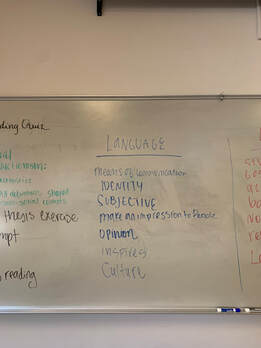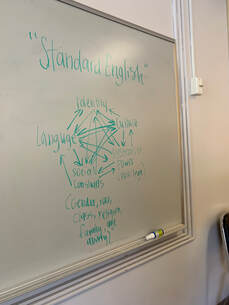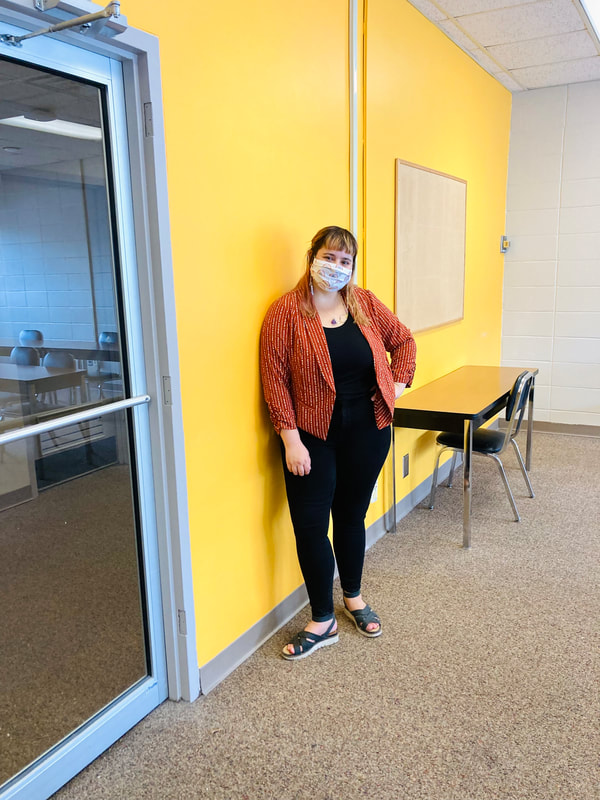|
Now that we are five weeks into the semester, we've settled into a routine. We had a rocky start to the semester with the unknowing that a rise in COVID-19 cases brought, lack of clarity from the administrative regarding our campus plan, and the impact of Hurricane Ida. Having two weeks free from those additional external complications helped a lot in terms of setting expectations and building a classroom space that is welcoming and inclusive. I'm getting to know my students, who are all fantastic and attentive, and I've enjoyed learning their names and embracing a classroom flow. In the past two weeks, they've turned in their first major project: a visual analysis. I have graded their projects and returned them with feedback. Clear feedback from teachers on student work is important to their progress and confidence (especially in first year writing courses) but, as a teacher, this process can feel daunting at times. Before I began writing feedback on student's submissions, I organized a set of pre-written comments in three levels (well done, decent attempt, needs considerable improvement) in a word document for each major component of their assignment. When I went to comment on their work, I began by addressing the student by name and adding a personalized sentence or two to each one in addition to the pre-written comment I copy and pasted in, but these pre-set comments on the necessary pieces of the project made the task feel significantly less overwhelming. I was still able to tailor my feedback student-by-student, but this process ensured that they knew why they were getting the grade they received and how to improve moving forward. It also standardized both my grading and responses. I've already received a few comments back from my students on their grades/feedback including one student who wrote, "I’m so thankful that you give such great comments. You are the only professor I have that communicates efficiently with their students." This response made me feel secure in my feedback process, although I used a list of pre-set comments to help outline each student response, it didn't alter their experience or decrease the usefulness of those comments. This past week, we've transitioned to discussing textual analysis. I noticed in our previous conversations that many students were not well acquainted with how to write a thesis nor how to summarize text. On Monday, we focused on summarizing text. During class, I prepared a PowerPoint with key points from the textbook followed by an in-class summary group activity. I provided each group with a few paragraphs about textual analysis, argumentative essays, summarizing etc. all from Purdue OWL's website, and each group had to summarize their section and then nominate one spokesperson to teach the class their part. This exercise engaged peer-assisted learning, summarizing skills, and peer-teaching. On Wednesday, I began class by writing our objectives for the class session on the board, as we always do. I also arrive a few minutes early to set up all the technology components and during that time, I typically play music through the computer speakers. Last week, I put a discussion board on the course canvas asking for music recommendations and I was pleased to see two people suggested bands/albums, so I picked one and played that while students funneled into class. We began the day by walking through the expectations of their next major assignment, a textual analysis. Then, I went through a short (~8 minutes) PowerPoint about crafting a thesis with examples. After that, they did an in-class independent activity where they had to pick a song and find the thesis of the song and write out a few bullet points of evidence for their thesis. My example was Jolene by Dolly Parton and I shared my thesis and ‘evidence’ which I had compiled the night before. They were extremely invested in this activity and wrote for almost fifteen minutes before I asked to hear a few volunteers share their thesis. I collected these at the end of class and made a Spotify playlist of their songs which I shared on the Canvas. https://open.spotify.com/playlist/6qOlW4WFGePW4AjbePEDbe?si=6da283f3b9134250 After our thesis activity, we shifted gears to talking about language and identity. I had them flip over the piece of paper they’d done their prior activity on and respond to two questions in complete sentences:
The next thing we did is that I wrote out the states they were from on the white board. I asked for them to tell me what people said about their state. In our class, everyone was from Mississippi, Louisiana, Alabama, or Texas. I do have one student from Florida, but she was sick that day. I wrote their responses about what people said about their states and commiserated with the Louisianians about how people have asked us if we have a pet alligator or took a boat to school. We took a moment to reflect on what people thought about us versus the truth. We also discussed how our ‘language,’ or how we sound often determines how people might respond to us. At this point, we had about 25 minutes of class remaining. I had them take a little less than 15 minutes to read Amy Tan’s Mother Tongue quietly to themselves, although it was assigned for homework. I told those who already read it to take notes and prepare something to say in response while others read it for the first time. While they read, I drew a picture on the board showing the interconnectedness between identity, language, culture, social constructs, and systems of power/privilege. I also wrote the definition of social constructionism, a sociological theory, on the board. When the timer went off, I quickly explained the picture I had drawn on the board and went through the definition alongside a quick explanation of why theories are useful to us in conversations and analysis. Then, I had students raise their hands and share what they thought about the essay we read. After each student commented, I related their comment to the picture on the board regarding the connections between language, identity, culture, power, and social constructs. As the clock told me I only had a minute or two left of class, I thanked them for their answers and reminded them of the homework and my office hours and they left for the day, depositing their papers on the desk as they left. Looking back on these weeks, we packed a lot of content into our class sessions, and I know we will continue to do so. I’m really proud of my students, who are predominantly freshmen, for being adaptable and trying hard despite the external circumstances of attending high school and now college in a global pandemic. I am excited to start talking about close reading next week and to dive into more course readings.
0 Comments
Leave a Reply. |
AuthorEmily M. Goldsmith (she/they) is a queer Cajun poet originally from Baton Rouge, Louisiana. They are currently a Ph.D. student at the University of Southern Mississippi. Archives
November 2021
Categories |



 RSS Feed
RSS Feed